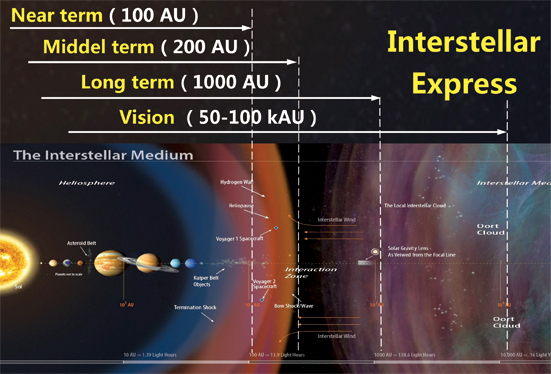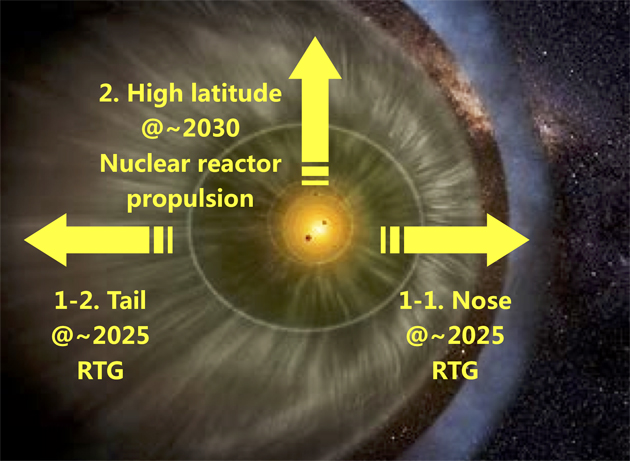By SONG Jianlan (Staff Reporter)
When the world is celebrating the one-year anniversary of Voyager 2’s crossing the boundary of heliosphere – the farthest reach of the solar wind as universally agreed, scientists at the Chinese Academy of Sciences are defining future journeys into this open cosmic water. Named “Interstellar Express”, this plan is to launch two probes in the near term, one going to the “nose”, and the other the “tail” part of the presumed comet-shape envelop of the heliosphere, which extends far beyond the realm of the Pluto.

A step-wise layout of the programme, with the near-term goal of exploration set within a distance of 100 astronomical units (or 9.3 billion miles) from the Sun. At this distance, the outer heliosphere ends and transits to the nearby interstellar medium. On the interface, the solar wind and the interstellar wind “bump” into each other, and radical disturbance bursts out in the plasma soup of energetic particles. Illustrated in the chart are the possible interactions occurring between the two regions and the equilibrium achieved on the enveloped surface – the boundary of the heliosphere where the solar wind pause and hence named “heliopause”. Seen on the upper right is the LOGO for the “Interstellar Express”. (Credit: NSSC)
Interstellar Express: A Chinese Messenger
The notion of the interstellar adventure comes to light at a forum convened on November 7 and 8, 2019 by the International Space Science Institute-Beijing (ISSI-BJ). As a partner institution of the International Space Science Institute (ISSI) in Bern, Switzerland, this institute is jointly established by ISSI and the National Space Science Centre (NSSC) under the Chinese Academy of Sciences (CAS) and operates as an independent entity.
At the forum, representative of the programme’s science team introduces the layout of the “Interstellar Express”, and experts from top science institutions around the world are invited to give advice to further define the science questions and objectives for this plan.

An illustration showing different layers of the heliosphere, a protective bubble formed by plasma particles sprayed by the Sun that envelops the planets in the solar system. The structure and dynamics of the heliosphere are largely unknown. Under “Interstellar Express”, a probe sent as part of the first mission will traverse the boundary (heliopause) of the bubble from its “nose”, whilst the other will go opposite way – to its tail. (Credit: Adapted from an image by NASA/IBEX/Adler planetarium)
Prof. WANG Chi, expert in space physics and director of NSSC, outlines the proposed programme. First initiated in 2014, the notion of Interstellar Express has evolved into an initial proposal after five years of concept and feasibility studies. Formulated in its roadmap are missions to be implemented in three stages, namely the near/middle-, long-term stages, and the vision. For the near-term, two probes will be sent in the first mission, heading in two opposite directions of the heliosphere. The two probes are expected to fly in 2025 if possible, and the one sent on the nose path is to arrive in the outer heliosphere by 2049, disclosed WANG. Another probe for high altitude exploration in the heliosphere will be sent in 2030 as the second mission.
With improved performance and aimed at measuring some neglected properties of the heliosphere, for example populations of energetic neutral atoms (ENA), the mission aims to fill in the large gaps in heliospheric physics and interstellar space observation.
The programme is open to international cooperation in terms of optimization of scientific objectives, payload contribution and mission-level synergetic observations.
The Only Mission to Fill the Gap
Near to the brim of the solar system, the solar wind and the interstellar wind bump into each other and stir up violent disturbance in the outer heliosphere – a “soup of plasma particles”. The rivals reach some dynamic equilibrium on the interface and hence form a stagnant boundary. The solar/interstellar wind pauses here, and hence the boundary is named heliopause. What exactly happening on this interface is hardly known, and hence has greatly interested scientists.
It took Voyagers, two probes sent into space by NASA in 1977, respectively 35 and 41 years to get to the heliopause. They traversed the boundary from two different points on the “nose” of the heliosphere envelop. The probes were originally expected to work for only five years; however, they well outlived the expectations and won over continued support for their maintenance and operation, and dramatically flew beyond the solar system. The two probes, the very first man-made spacecraft beyond the protection of “the womb of humanity”, are still flying in the interstellar space, where every inch of journey means discovery and surprise.
Their power systems are fading out, though; and their thrusters degrading. Experts are worried that they might not last long. “Voyagers might not last beyond 2025,” warns Dr. Robert Wimmer-Schweingruber, University of Kiel, Germany. His team just submitted last August a white paper to the European Space Agency (ESA)’s Voyage 2050 Initiative, a long-term planning aimed at defining this agency’s future space explorations. In the white paper his team urged the Agency to launch during the time between 2030 and 2050 a mission termed “Interstellar Probe” for in-situ measurement of the interstellar medium, citing importance of understanding this part of the cosmos and the vast knowledge gap.
“After 2025, there might be nothing there working in the interstellar space,” says Dr. Ralph L. McNutt, chair of the panel for interstellar exploration under COSPAR, the Committee on Space Research under the International Science Council (ISC, formerly the International Council of Scientific Unions, ICSU). Dr. McNutt also works as chief scientist for the Space Department of the Applied Physics Laboratory (APL) at Johns Hopkins University, USA. His team has been working on the concept of an interstellar probe, which is expected to be launched by January 1, 2030, if funding agencies give it green light.
“Interstellar Express” is the only one designed to be launched in the next decade to fill the vast gap. “I know no other mission flying there about the same time,” Dr. McNutt said when asked of possible candidate interstellar probes to come.
It will take “Interstellar Express” less time than Voyagers to fly there, if the proposal gets approved by Chinese authorities. Still, however, it will take it about 25 years to approach and traverse the heliopause – Far long enough to beat any other space mission in China to become the longest of the country.
“It would be exciting if the Chinese Government supports a science mission lasting for decades,” comments Dr. Maurizio Falanga, Executive Director of ISSI-BJ, who is one of the conveners of the forum. “It takes great patience to sow a seed and take care of the sprout that will not bear fruits in decades.”
“ISSI-BJ runs the forum as an open platform where excellent experts across the world can exchange their ideas and work together to improve a research project,” he added. “We encourage worldwide cooperation to advance research in the field of space science.”
Understanding the Heliosphere
An important goal of the forum is to define the most valuable scientific objectives respectively for the probes heading to the two opposite directions in the first mission. On the other hand, experts are consulted with what the binary probe could do on its journey to the destinations, to maximize its scientific outputs. Also, the forum seeks proposals on payload specifications and design.
The mission is to perform in-situ observations on the dynamics of solar plasma particles in the outer heliosphere. Though pioneer in-situ measurements made by Voyagers, as well as remote observations by the Interstellar Boundary Explorer (IBEX) and Cassini have yielded very valuable and inspiring data, still lots of questions remain open to investigate for human beings. Actually, the new data has raised new questions. For example, the sharply dropped counts of solar particles detected by Voyagers indicate a clear boundary existing between the heliosphere and the interstellar space outside; however, it remains an enigma what this envelop looks like.
It could look like a croissant, comments Dr. Merav Opher from Boston University, USA. She reviewed different models predicting the shape of this shield of our solar system and concludes that the data from IBEX and Cassini’s observation prefer shapes other than the classical comet-like envelop. She also gives the results from her team’s calculation: the magnetic field of the Sun confines the solar wind in a croissant-shape sheath.
This makes the journey to the “tail” necessary and interesting. Interstellar Express, which seeks to explore the heliosphere in different directions, stands out to fill the knowledge gap concerning the basic structure of this shield.
A clearer mapping of the outer heliosphere will help scientists better understand the origin and evolution of the solar wind, which ultimately affect the everyday life of human beings.

NASA’s voyager 1 and 2 crossed the edge of the heliosphere in Aug 2012 and November 2018, respectively. Depicted on the map are the positions of the two spacecraft as of December 2018. They both penetrated the boundary (heliopause) of the bubble from the “nose” part of the heliosphere. (Credit: NASA/JPL-Caltech)
Looking at the Interstellar Space
How the particles in the two regions interact with each other has intrigued many scientists. “Could it be a hole on the heliosphere envelop?” Comments Prof. Vladimir Florinski, University of Alabama at Huntsville, USA, when reporting his simulation of magnetic trapping of local interstellar medium particles, based on the data from Voyagers. He has identified a region on the “nose” where galactic cosmic rays might have direct access to the heliosphere, and suspects it could be a possible “opening” on the heliosphere allowing the interstellar wind to penetrate in. “This could be a promising direction to explore with the Interstellar Express,” he suggests when concluding his talk.
Also, the scientists are curious about the nature of the interstellar medium, which contains lots of particles alien to the solar system — Where have all the particles come from? What physical processes are responsible for their origin?
All this has made the dynamics of the particles an important objective of the mission. Its future observations on the local interstellar medium might provide clues for some far-reaching science issues of fundamental importance.
“Plasma physics is fundamental, because as you know, 99% of the visible universe is in the state of plasma,” says Dr. Wimmer-Schweingruber, when talking about how the in-situ investigation of the interstellar medium might inform research in fundamental physics. Meanwhile he emphasizes the importance of in-situ observations: “It is time to move out from our interstellar womb. The observed could be very different from what we have thought. It is very important to go out there! We might not be able to see that, given the mission duration; but our kids will.”

